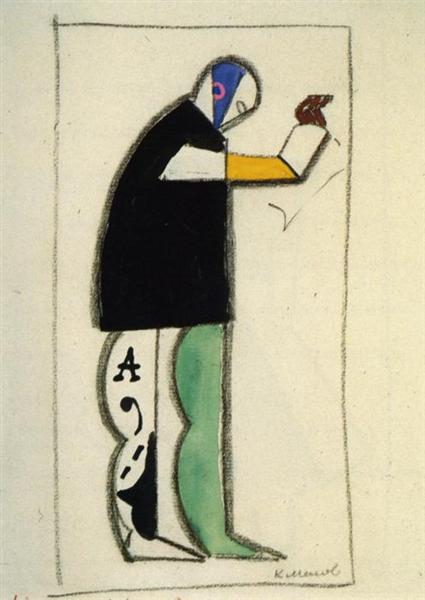Description
Amid the constant search to redefine art canons, Kazimir Malevich emerges as an unavoidable visionary. His "reciter" work of 1913 is a visual manifesto of the transition to a new artistic language that distrusts traditional forms and establishes the bases of suprematism, movement of which Malevich is a pioneer. The "reciter" painting, although prior to the formal suprematist of 1915, already exhibits signs of the geometric abstraction and decomposition that would become the emblem of their artistic practice.
"Reciter" shows a central figure that evokes a human being, perhaps in the midst of a declamation, as the title suggests. However, what immediately captures the viewer's attention is the complex geometric configuration of the figure and the way in which the space is fragmented in a caleidoscope of colors and shapes. At first glance, it might seem a cubist work in its essence, but Malevich goes further, transcending the mere fragmentation of physical reality to address a more metaphysical and conceptual vision.
The composition of the work is intricate and challenging, characterized by the juxtaposition of straight lines and curves that are intertwined and overlap by creating an almost three -dimensional structure. The colors used, an essentially primary palette that oscillates between red, blue and green with complementary nuances, generate a dynamism that gives the image of a vibrant internal energy. These color elements not only stand out for their purity, but also because they are arranged in a way that highlights the imbalance and tension, qualities that Malevich uses to express the emotional intensity and complexity of the act of reciting.
In terms of characters, the figure of the reciter is fragmented in a myriad of planes and angles, blurring the borders between the bottom and the form, which invites a less literal and more symbolic or intuitive interpretation. The absence of realistic details in the portrait emphasizes the universality of the gesture of the recited, making it an archetype rather than a specific individual.
Malevich was born in 1879 in kyiv, Ukraine, and his first foray into the avant -garde places him in a close proximity with futurism and cubism. However, his work would promptly advance towards a form of pure abstraction, detached from any reference to the material world. "Reciter" is on the threshold of this transition, positioning between the cube-fouturism that Malevich explored and the radical suprematism that would introduce soon.
Supremeism, focused on the supremacy of pure sensitivity in art, rejects any objective representation and opts for simple geometric shapes and basic colors. Although "reciter" still maintains certain figurative echoes, the future direction is already suggested with its preeminence of geometric structures.
The "reciter" study offers us a broader understanding of Malevich's evolution and the significance of his contribution to modern art. His genius lies in his ability to transform the visible into a spiritual and emotional experience, ciming the way to new forms of artistic expression that until then had not been contemplated. In "reciter", Malevich leaves us an enigmatic track, a work that invites us to listen beyond sound and see beyond the figure, thus discovering the deep potential of art as a means of exploration and revelation of the human spirit.
KUADROS ©, a famous paint on your wall.
Hand-made oil painting reproductions, with the quality of professional artists and the distinctive seal of KUADROS ©.
Art reproduction service with satisfaction guarantee. If you are not completely satisfied with the replica of your painting, we refund your money 100%.

